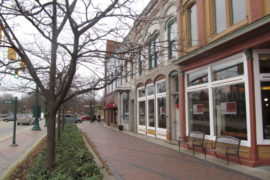Jerry Nordblom and Doug Koop of the Legacy Land Conservancy spoke at Dexter Rotary’s weekly breakfast last Thursday, Feb. 8, about the efforts to preserve the area’s natural landscape.
Legacy Land Conservancy is a private, non-profit organization that works with individuals, landowners, organizations, and local government to protect forests, prairies, farms, wetlands, and water in perpetuity.
Board of Trustees President, Jerry Nordblom, told the group about his experience of moving here and immediately falling in love with the area. “When I retired, we moved from a lot that took me ten minutes to mow to seven-and-a-half acres in Webster Township with seven acres of lawn,” he jokes. “We discovered we had sandhill cranes nesting in the bordering wetland,” he says. “We had a nest of long-eared owls, which are very, very rare, on our property and a family of baby kit foxes right behind our house.”

Founded in 1971 as the state’s first local land trust, Legacy Land Conservancy has worked tirelessly for more than 40 years now to protect beautiful places like Jerry’s and the unique character of southeast Michigan. Throughout the years, Legacy has led successful campaigns to secure funding to protect thousands of acres of land from the threat of development.
Nordblom purchased another 25 acres of wetland and woodlands adjacent to his property to prevent it from development. He told the group, “When we first got here, we noticed how happy everyone was that lived in this area and that had a lot to do with the rural landscape.” That observation then led to another thought for Jerry: “We know there had to be some way we could protect this property for the future,” he said.
Legacy has saved key farmland parcels to help support agriculture and conserved natural corridors to support public recreation, protect wildlife habitat, and ensure clean water. Jerry was introduced to Legacy Land Conservancy and his idea of preserving the place he loves so much for others to also enjoy became a reality.
Working through the Legacy Land Conservancy, Nordblom was able to preserve his property in its natural state for perpetuity. “The conservation easement goes with the deed of the property,” he explains. “It will never be developed and I will continue to live there.” He adds, “Nobody in the future will be able to develop it and it just makes me feel good to know that we’re not going to have any buildings in my swamp.”
Nordblom is not alone. Land conservancy is a rapidly growing movement. Executive Director for Legacy Land Conservancy, Doug Koop, told the gathering, “When I started in land conservancy in the late nineties, there were about six-hundred land trusts across the country. This was a time when not a lot of people were thinking about the legacy of protecting their land. In the last decade or so has exploded over the country.”
“Now,” he adds, “Legacy Land Conservancy is one of 40 land conservancies in the State of Michigan. We’re one of about 1,700 land trusts across the country.”
The whole thing has the feel of a grass roots movement. “If you put us all together, land trusts are now the largest environmental organization,” Koop says. “Millions of supporters and thousands of acres of land each year are protected. The power of what we do in land trust is we work directly with land owners.”
In 2008, Legacy Land Conservancy set a goal of protecting 25,000 acres of key green areas in Washtenaw and Jackson Counties. This “Emerald Arc” extends from Pinckney State Recreation Area on the north, to Hayes State Park on the south. It includes portions of the Huron, Raisin, Grand, and Kalamazoo rivers.
The idea of the Emerald Arc was actually first conceived 80 years ago during the Great Depression when a group of folks had a vision for a series of connected parks throughout the Huron River and Clinton River watersheds to provide recreation for a rapidly growing population. This vision has since expanded to include protection of both public and private lands for a wider range of benefits including water quality, habitat corridors, agricultural production, and trails connecting large blocks of recreational land.
From Legacy’s website, the Emerald Arc is described as “More than a place, the Emerald Arc is an idea: that we can provide significant open spaces for ourselves, for our neighbors, forever. Building on the generous legacy of prior generations, the Arc will protect lands that increase public access, protect fresh waters, encourage local agriculture, and preserve wildlife habitat.”
Land conservancy is insulation against the fluctuating currents of public interest. Koop explains: “The interesting thing I’ve noticed is that Ann Arbor is really growing internally (within the city limits) and that’s a benefit to what we’re trying to do with the land. That trend will happen for awhile and then you’ll have people want to get out of that urban area and back into the rural landscape. It switches back and forth between generations. So when that time comes again, the land will be protected from urban sprawl.”
Legacy Land Conservancy has already secured 8,400 acres against future development with plans of adding another 1,200 in the near future as a result of growing public support.
Koop says, “Having these landscapes protected and connected is vital to the public interest.”
If you would like to learn more about Legacy Land Conservancy you can find more information on their website.







